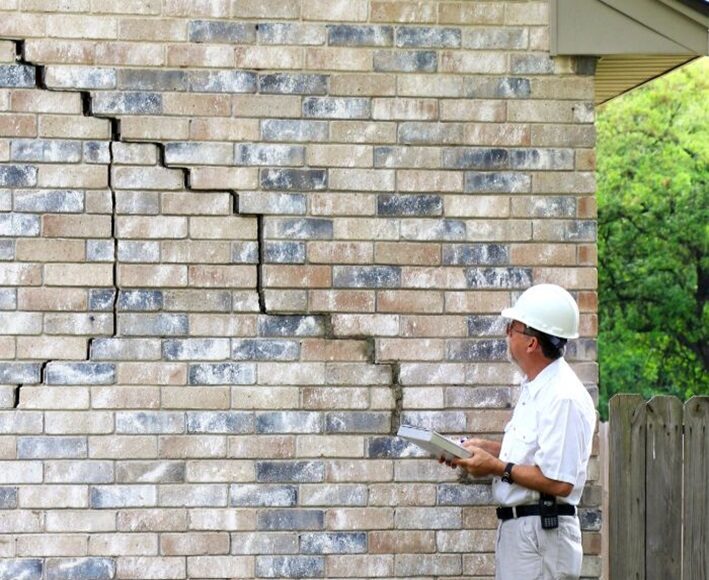A strong foundation is essential for the structural integrity of any building. However, over time, foundations can develop cracks that raise concerns for homeowners and property owners alike. These cracks can vary in type and severity, each potentially indicating different underlying issues. In this article, we will delve into the world of foundation cracks, understanding their meanings, and highlighting the actions that need to be taken based on their characteristics.
This information is presented by one of the local waterproofing companies in Toledo. Please reach out if you have any questions.
Vertical Cracks: A Sign of Settling
Vertical cracks are perhaps the most common type of cracks found in foundations. They run straight up and down, often starting from the top of the foundation and extending downwards. Vertical cracks are generally considered normal in the early stages of a building’s life, as they are often a result of the natural settling process. However, if these cracks exceed a width of 1/8 inch, they might require closer attention.
Horizontal Cracks: Potential Hydrostatic Pressure
Horizontal cracks are a cause for more serious concern. These cracks run sideways along the foundation walls and are often indicative of external pressure exerted on the foundation. One of the primary reasons behind horizontal cracks is hydrostatic pressure, which occurs when water builds up in the soil surrounding the foundation. This water exerts immense pressure on the walls, leading to cracking. Horizontal cracks demand immediate professional evaluation, as they can compromise the structural stability of the entire building.
Stair-Step Cracks: Shifting Earth and Settling
Stair-step cracks are named for their appearance – they look like a set of stairs or steps along the mortar joints in brick or concrete block walls. These cracks can be both vertical and diagonal in nature. Stair-step cracks often indicate that the ground beneath the foundation is shifting or settling unevenly. This can be a natural process, but it can also be a sign of a more serious issue. It’s crucial to monitor the width and progression of stair-step cracks and seek expert advice if they widen or spread over time.
Diagonal Cracks: Differential Settlement or Structural Stress
Diagonal cracks can be particularly perplexing, as their underlying causes can vary widely. If a diagonal crack is wider at the top than at the bottom, it might be due to differential settlement. This occurs when one part of the foundation settles more than another, causing uneven stress on the walls. On the other hand, if the crack is wider at the bottom, it could be a sign of structural stress caused by excessive vertical pressure. In either case, diagonal cracks should be inspected by professionals to determine their origin and severity.
Crack Width: A Key Indicator
The width of a foundation crack is a significant factor in assessing its severity. Using a ruler, measure the width of the crack at its widest point.
- If the crack is less than 1/8 inch wide, it is likely not a major concern and may just be a result of normal settling.
- Cracks between 1/8 and 1/4 inch wide might warrant closer observation, and cracks wider than 1/4 inch should be examined by a foundation specialist without delay.
Seeking Professional Help
When dealing with foundation cracks, it’s crucial to engage the services of a professional foundation inspector or structural engineer. These experts can provide a thorough assessment of the cracks, their causes, and the potential risks they pose. Foundation professionals have the experience and knowledge to differentiate between harmless cracks and those that require immediate attention.
- Crack Width and Progression: If a crack exceeds 1/8 inch in width or shows signs of widening, extending, or branching, it’s time to consult professionals. Monitoring crack development helps experts diagnose the underlying issue accurately.
- Pattern Recognition: Professionals can identify specific crack patterns that indicate causes such as soil movement, hydrostatic pressure, or structural stress, guiding them to pinpoint the root problem.
- Multiple or Different Types of Cracks: The presence of multiple cracks or a mix of crack types suggests complex issues. Professionals can untangle these complexities and provide a comprehensive assessment.
- Expert Diagnosis: Trained inspectors use specialized tools and techniques to conduct a thorough assessment, offering insights beyond what’s visible on the surface.
- Preventive Measures: Even if cracks seem minor, professionals can recommend preventive actions to avoid potential future problems, such as improving drainage or reinforcing the foundation.
- Peace of Mind: Engaging professionals alleviates stress by providing accurate information, clear explanations, and guidance on necessary steps to address the issue effectively.
Conclusion: Addressing Foundation Cracks Proactively
Foundation cracks are not an uncommon occurrence, but they should never be ignored. Understanding the different types of cracks and their potential implications can empower homeowners and property owners to take the right actions at the right time. Whether it’s vertical cracks from settling, horizontal cracks due to hydrostatic pressure, stair-step cracks indicating shifting earth, or diagonal cracks revealing differential settlement or structural stress, each type of crack carries its own story. By monitoring crack width and seeking professional assistance when necessary, property owners can ensure the longevity and safety of their structures for years to come. Remember, when it comes to foundation cracks, early intervention is key.



